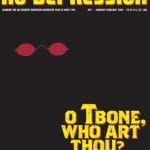Slim Bryant – The professional
“Slim Bryant and his Wildcats, popular Pittsburgh radio stars, will be the featured attraction at West View Park’s Talkie Temple today. Slim and his boys will present their usual varied program, well spiced with singing, dancing and comic numbers.”
— Pittsburgh Press, August 15, 1948
He bought the modest yellow brick and white aluminum siding colonial in 1949. It sits on a steep hillside along a yellow-brick paved street alongside other tidy homes built after World War II in Dormont, Pennsylvania, just south of the Pittsburgh city line. Slim Bryant and his late wife Mary Jane raised their son Thomas here.
At 95, Bryant remains the consummate pro. He stands tall (6-foot-3 to be exact); his smile is warm, his handshake firm, his Georgia-tinged voice still rich and resonant. Inside, the home is neat, simply decorated with a minimum of frills. In one corner of the dining room, his 1937 Gibson L-5 archtop, its pickguard worn from nearly seven decades of use, is perched on a stand next to a briefcase-sized amp. He uses it to teach guitar twice weekly at a local music store.
While scholars have long seen Slim Bryant as a footnote to others’ careers, today, he’s virtually the last living link to commercial country’s earliest days. For nearly a decade, he bounced around radio stations with fiddle giant Clayton McMichen, with whom he shares co-writer credit on “In The Pines”. Bryant penned the Jimmie Rodgers standard “Mother, The Queen Of My Heart”, and recorded that song with Rodgers in 1932.
“I have to walk with a cane, but I’m lucky I’m not bedfast,” he says in early November. He braved a near-constant blanket of snow that covered Southwestern Pennsylvania in early 2003 to run a snowblower. Moving out to the alley from the driveway behind the house, he slipped on the icy bricks and fell, fracturing his left hip, arm and leg. After nearly a week in the hospital, he spent 38 miserable days recuperating in a nursing home before returning to his own place.
Bryant credits a self-created fitness program that he followed for decades with saving him from permanent incarceration. His doctors agreed. “I exercise twice a day for 22 minutes, 44 minutes a day,” he says. Cane aside, his posture remains ramrod-straight. He still drives during daylight. While the arm injury made playing guitar more difficult, doctors encouraged him to play half an hour daily to strengthen his shoulder.
The fall of 2003 has been busy. In September, he traveled to Wheeling, West Virginia, to participate in a documentary on Jimmie Rodgers. There, he met and chatted for the cameras with Rodgers disciple Merle Haggard, who was performing at the Capitol Music Hall. During the concert, Haggard brought Bryant onstage. After the show, Slim signed autographs. He hosted another crew in late October, this one preparing a documentary on the WLS National Barn Dance. He spends four hours with a photographer, ever cooperative, always ready with an anecdote or observation.
In a field dominated by artists who excelled musically and failed financially, Bryant was a supreme pragmatist who never separated art from commerce. City-born, he gave up a secure career as an electrician for professional music, but only after formal guitar study. Perceived as a “classic” country performer, his musical perspective was inextricably linked to the pop and jazz he loved. In the end, he became an institution in, of all places, Pittsburgh.
We first sat at his dining room table for three hours on a humid, stormy day in July 2002. In that time he arose only twice: once to answer the phone — a wrong number — and again to bring out scrapbooks and more recent articles on his career and old songbooks. His recall of events that occurred seven decades ago is phenomenal. Double-checking his stories against other sources only confirms his veracity.
Thomas Hoyt Bryant, a middle-class child of the New South, was born in Atlanta on December 7, 1908, the first child of Posey Milton Bryant and his wife Auroria. Posey, an electrician, played fiddle to relax. “He played old fiddle tunes, jigs and reels and those kinds of things,” Bryant says. “He played one thing that only one person I ever knew [ever] heard the tune. He called it ‘Soap Suds Against The Fence’. And this person I knew said it was ‘Soap Suds Over The Fence’. I never knew what that meant. But that was one of his favorite tunes.
“Mom played piano and guitar. She played the fingerstyle guitar — a tune called the ‘Spanish Fandango’. I’ll never forget that. She was a wonderful influence on me, although I never learned to play the guitar until I graduated from high school.”
Her playing reflected the guitar’s status in the last century, when it gained favor as a “parlor” instrument for women. Auroria was also a poet. “I think that’s where I got my songwriting ability from,” he says proudly. “She read, was crazy about puzzles and had a wonderful mind.” She gave him his longevity as well: “She lived to be 104 years old.”
As with many kids of that day, radio became a youthful pastime for Slim. Building himself a primitive crystal set, he listened to KDKA in Pittsburgh, which became America’s first commercial broadcast outlet in 1920. Two years later, Atlanta’s WSB took to the air, followed by Nashville’s WSM in 1925. He heard them all.
Though it’s not always recognized as such, 1920s Atlanta was the birthplace of commercial country music. The first fiddlers’ conventions at the City Auditorium began around 1913. Historian Wayne Daniel points out that just eight days after WSB made its debut, Fiddlin’ John Carson showed up, asking to play. His bottomless wellspring of fiddle tunes made him an instant hit. That popularity led to the historic 1923 recording session that yielded the first commercial country record: Carson’s “The Little Old Log Cabin In The Lane”.
Weeks after Carson’s 1922 radio debut, Clayton McMichen and his Hometown Boys played on a WSB broadcast. McMichen was a study in paradox. Born in Allatoona, Georgia, in 1900, he was raised in Atlanta, his dad fiddling old-time tunes and formal waltzes. Clayton became an old-time fiddle prodigy in his teens and later a mechanic by trade. In 1923 his friend Lowe Stokes taught him to play long bow strokes while fiddling. It made his playing smoother and richer.




